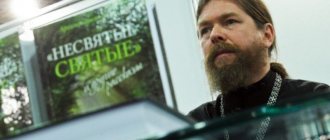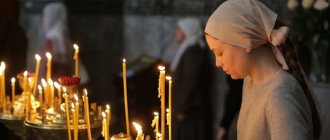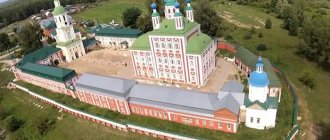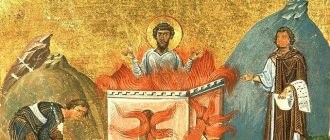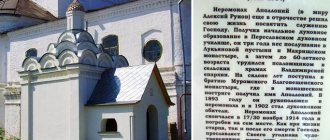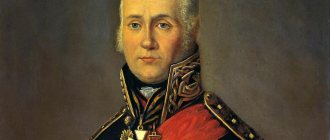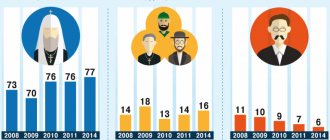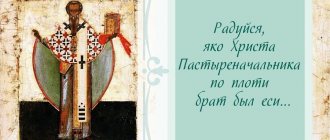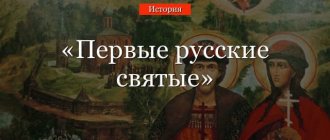"Save me, God!".
Thank you for visiting our website, before you start studying the information, please subscribe to our Orthodox community on Instagram, Lord, Save and Preserve † - https://www.instagram.com/spasi.gospodi/. The community has more than 60,000 subscribers. There are many of us like-minded people and we are growing quickly, we post prayers, sayings of saints, prayer requests, and timely post useful information about holidays and Orthodox events... Subscribe. Guardian Angel to you!
Many Christians immediately associate his name with healing, and there is a lot of evidence of this. Prayer to St. Theodore of Sanaksar can help even in the most difficult life situations.
Life of St. Theodore
In worldly life he is known as the nobleman Ivan Ignatievich Ushakov. He was born in the Yaroslavl province in 1718. Initially, his parents assigned him to military service in St. Petersburg, where the Preobrazhensky Guards Regiment was based. Perhaps he would have become a great commander-in-chief, but chance intervened in the life of Theodore of Sanaksar.
One day, while walking, his friend fell dead. It was this fact that showed him how unstable happiness is in this world. At the age of 20, he gives up everything and becomes a recluse. At first he stayed in the thicket of the forest on the banks of the Dvina, and then in the cell of the Ploshchanskaya hermitage. Due to lack of documents, he was captured and transported to St. Petersburg.
These six years have significantly changed his appearance. The humility in him was a special wonder for everyone. The Empress forgave him for his escape and returned all his previous ranks, but he asked permission to become a monk. After some time, this event happened in the Alexander Nevsky Lavra. He always had a desire to go to the Sarov monastery. In 1757, with some of his followers, he went there.
The best article for you, go to: Holy Apostles Peter and Paul: icon, prayer, day of celebration
The girls were settled in the St. Nicholas Monastery, and the men settled in the Sarov desert. After spending two years there, he went to the Sanaksar monastery with the goal of restoring it. Philanthropists helped him in this. In 1762 he was ordained a hieromonk. Everyone noted his severity and firmness.
Days of Honor
In 1774, due to denunciation, he was exiled to the Solovetsky Monastery. Only after 9 years he was able to return back. He died in 1791. Remembrance days fall on:
- March 4;
- May 4th;
- June 5.
Righteous Theodore of Sanaksar and other saints of the Transfiguration
April 21 / May 4 The Church honors the memory of the righteous Theodore of Sanaksar. Before embarking on the path of spiritual warfare, Ivan Ushakov - this is the worldly name of the ascetic - served for eight years in the Life Guards Preobrazhensky Regiment. This regiment wrote many pages in the history of Russia - both heroic and dramatic, and the chronicle of the regiment itself is unthinkable without the names of those Transfigurations whom the Russian Orthodox Church glorified as saints.
St. Theodore of Sanaksar
Two years ago, on April 9, 2013, by decree of the President of Russia, the Preobrazhensky Regiment was restored. This spring, the second anniversary of the revival of the glorious Russian regiment almost coincided with Easter. And in this regard, I would like to touch on a topic that is directly related to both the Preobrazhensky Regiment and Orthodoxy.
Throughout its history, the Preobrazhensky Regiment was a source of personnel for military and civil service, and the mere mention of the names of G.R. Derzhavina, N.M. Karamzina, M.P. Mussorgsky and Grand Duke K.K. Romanov (K.R.) is enough to understand the regiment’s contribution to the cultural treasury of Russia.
At the same time, the fact that several Russian saints did active military service in the regiment remains unexplored. Even in their lives, information about this is sometimes hidden - only a vague indication of service in the guard is given. Histories of the regiment written before the revolution or abroad also do not contain any data on this matter. And the reason is not at all the indifference of researchers to the issue that interests us, but the fact that only in our time, at the end of the 20th - beginning of the 21st century, the Russian Orthodox Church glorified a number of Transfiguration men as saints.
Thus, in 2004[1] the Bishops' Council of the Russian Orthodox Church glorified St. Theodore of Sanaksar (1718–1791)[2], in the world Ivan Ignatievich Ushakov, who served in the Life Guards Preobrazhensky Regiment for eight long years - from 1735 to 1743.
Coming from an ancient family, he began his service in the regiment as a soldier in the bombardment company, and after the palace coup carried out in 1740 with the help of the Preobrazhensky Regiment, among other Preobrazhentsev, he was granted the rank of sergeant by the new ruler of Russia Elizaveta Petrovna.
In the spring-summer of 1743, Ushakov went home on leave, but, having driven a little away from St. Petersburg, he sent his servant with the horses back, and he, having changed into pre-stocked beggar clothes, went north, striving for desert life in the Pomeranian forests. As the life of Saint Theodore writes, the impetus for such an act was the sudden death of one of the young guard officers that had occurred shortly before during a feast.
After several years of wandering, he was caught by a detective team pursuing those living in the forests, and as a sergeant of the guard, he was sent for personal presentation to Empress Elizabeth Petrovna. The Empress forgave Ushakov and offered to return back to the regiment (“Why did you secretly leave my regiment?”). Ushakov refused, asking to be allowed to become a monk. Elizaveta Petrovna fulfilled his request, and in 1747 (according to other sources - in 1748) in the Alexander Nevsky Lavra he was tonsured a monk with the name Theodore. The fame of the “extraordinary monk” (as he was called by the heir to the throne Peter Fedorovich - the future Peter III) spread throughout St. Petersburg, and an increasing number of people, including fellow soldiers, began to turn to him for advice and guidance. In 1759, after a series of misadventures, he moved to the Sanaksar desert.
Already during the reign of Catherine II, who worked a lot in the field of destroying monasticism in Russia, through the efforts of Father Theodore, the Sanaksar hermitage was not only preserved, but also named a monastery. In 1763, the empress's consent was received to tonsure 12 students of Father Theodore from retired guardsmen (from the Preobrazhensky and Izmailovsky regiments). Subsequently, the staff of the monastery increased mainly due to retired military personnel.
The military considered the Sanaksar monastery “their” monastery
To save the monastery, Father Theodore interceded with his fellow soldier Count A.G. Orlov-Chesmensky, brother of the all-powerful favorite of Catherine II G.G. Orlova. Subsequently, at the request of Count A.G. Orlov-Chesmensky, the empress allocated significant funds for the construction of a new stone church in the monastery. The main donors for the entire construction period remained St. Petersburg residents, especially the military, who considered Sanaksar “their” monastery.
St. Theodore Ushakov
Three brothers of Father Theodore also served in the Preobrazhensky Regiment - Sila (from 1724), Fedor (from 1727) and Alexey (from 1736).
The son of Fedor - the great Russian naval commander Fedor Fedorovich Ushakov - was also glorified in 2004 by the Russian Orthodox Church as a saint as the righteous warrior Feodor Ushakov.
The relics of the holy warrior Theodore rest next to the relics of his uncle Saint Theodore of Sanaksar in the Sanaksar monastery. Zakharia Vasilyevich Verkhovsky was appointed captain of the Preobrazhensky Regiment [3]. Like Father Theodore, Zacharias was the third brother to enlist in the Preobrazhensky Regiment - his two older brothers, Philip and Ilya, had already served in the regiment since 1776.
The Verkhovsky brothers came from an old Polish noble family. Their ancestors converted to Orthodoxy and entered the service of the Russian Tsar after the recapture of Smolensk from Poland during the reign of Alexei Mikhailovich.
Having risen to the rank of captain, Ilya retired from the regiment in 1787, and a year later, Philip.
Zachariah received the rank of sergeant in 1787 and, taking a year off, went to the estate. However, he never returned to service. Having received a full dismissal with the rank of lieutenant in 1789, Zacharias, like Father Theodore of Sanaksar half a century earlier, went into the forest as a hermit, from there he moved to the Konevetsky Monastery, where in 1790/1791 he was tonsured a monk with the name Zosima.
The life of Father Zosima says that his spiritual path was predetermined before his birth: his father was told during prayer that he would have a son, who would need to be taught only the Law of God. And yet, despite the fact that from childhood Zacharias was predisposed specifically to monasticism, he was enrolled in the guard and was able to enter the monastery only after the death of his parents.
St. Zosima Verkhovsky
Subsequently, he traveled a lot throughout Russia, lived in Siberia, and founded two monasteries. He had a great spiritual influence on monasticism, including through his spiritual writings. In the middle of the 19th century, his name was mentioned among the great ascetics of the faith in Russia, and yet his contemporaries included Saint Seraphim of Sarov, and Saint Philaret (Drozdov), and Saint Tikhon of Zadonsk, and Saint Theodore of Sanaksar, and such pillars of the Optina Hermitage as Saint Leo , Macarius and Moses of Optina.
Father Zosima (Verkhovsky) is one of the prototypes of Elder Zosima in the novel The Brothers Karamazov
A number of studies note that it was Father Zosima (Verkhovsky) who was one of the prototypes used by F.M. Dostoevsky to create the image of the elder Zosima in the novel “The Brothers Karamazov”.
Together with his senior fellow soldier Ivan Ushakov - Father Theodore of Sanaksar - Father Zosima (Verkhovsky) was glorified as a saint by the same Council of Bishops of the Russian Orthodox Church in 2004[4].
Father Zosima was a disciple and closest friend of the Venerable Basilisk of Siberia, about whom Saint Ignatius (Brianchaninov) wrote: “In our century, as far as the writer of this Word is aware, two monks were honored to see their soul depart from the body during prayer: the Siberian hermit monk Basilisk, who died in 1825, and the Nikiforov Hermitage, Schemamonk Ignatius, who died in 1852. <…> With the closest disciples of the first, the compiler of the Word was honored with cohabitation and friendship in the Lord”[5]. From the last lines we can assume that it was Father Zosima that Saint Ignatius had in mind. It should be noted here that the grandfather of Saint Ignatius, Semyon Andreevich Bryanchaninov, was also a Preobrazhenian, having served in the regiment for two years - from 1771 to 1772.
St. Ignatius Brianchaninov
Almost 100 years after Zakhary Verkhovsky’s Preobrazhensky Life Guards entered the Preobrazhensky Regiment, a graduate of the Corps of Pages, warrant officer
Alexey Borisovich Neidgardt (1863–1918), became a Preobrazhensky [6].
His father B.A. also served in the Preobrazhensky Regiment. Neidgardt, and brother Dmitry, and his great-great-grandfather A.V. Suvorov was enlisted in the Preobrazhensky regiment as a lieutenant colonel as a reward for the capture of Izmail. A.B. Neidgardt served in the regiment for four years, from 1883 to 1887, after which he went into the reserve. In 1894 he was dismissed from service with the rank of lieutenant of the Guard. Returning to his estate in the Nizhny Novgorod province, he was engaged in economic activities for a long time, and then was elected Nizhny Novgorod provincial leader of the nobility (from 1897 to 1917). In 1906, he was elected a member of the State Council from the Nizhny Novgorod Provincial Zemstvo Assembly. Neidgardt actively supported the policies of P.A. Stolypin, whose wife was Neidgardt’s sister Olga (his second sister was married to Foreign Minister S.D. Sazonov).
Alexey Borisovich Neidgardt
A.B. Neidgardt was a generous philanthropist, donating to the construction of churches in the Nizhny Novgorod province, and was a trustee of several shelters and educational institutions. In 1914, he was appointed ktitor of the Feodorovsky Cathedral, built in memory of the 300th anniversary of the reign of the House of Romanov.
Alexey Neidgardt was among those who signed a protest against the closure of churches and the confiscation of church property
After the revolution A.B. Neidgardt returned to the Nizhny Novgorod region. On June 7, 1918, Alexei Neidgardt was one of those who were not afraid to sign an appeal to the flock calling on them to protest against the closure of Orthodox churches, monasteries and the confiscation of church property. Soon all those who signed the appeal were arrested by the Soviet authorities and accused of calling for counter-revolutionary activities. On the night of November 6-7, 1918, on the anniversary of the Great October Socialist Revolution, Alexey Neidgardt, along with Bishop Lavrenty (Knyazev) and Archpriest Alexy Porfiryev, was shot. In 2000, the martyr Alexy was glorified as a saint by the Council of Bishops of the Russian Orthodox Church.
The Red Terror, which included A.B. Neidgardt, began with the murder of the royal family on the night of July 16-17, 1918. Two of those villainously killed that night were Preobrazhentsy - Emperor Nicholas II and his son Alexei.
St. Passion-Bearer Nicholas II in the uniform of His Majesty's Life Guards Regiment
Of all the Russian autocrats, it was Nicholas II who was most closely associated with the Preobrazhensky Regiment. He was enrolled in the regiment from birth (May 6, 1868). On December 12, 1877, at the age of 9, he first joined the regiment as an assistant at the banner. He served in the regiment: in the summer of 1887 - as a junior officer in the company of His Imperial Majesty, in the summer of 1888 - as commander of the company of His Imperial Majesty. Finally, on 1 January 1893, he was appointed commander of the 1st Battalion, a rank he retained until the end of his reign. From that moment until the fateful March 1917, Nicholas II remained the August Chief of the Preobrazhensky Regiment.
It was with the rank of commander of the 1st battalion of the Preobrazhensky Regiment that Nicholas II ascended the throne after the death of his father in 1894. From the diary of Grand Duke Konstantin Konstantinovich Romanov, at that time commander of the Life Guards Preobrazhensky Regiment: “The Tsar [Alexander III] was laid in a coffin in the Preobrazhensky uniform - as I hoped. The young Tsar [Nicholas II] did not even have time to surrender a battalion. Therefore, until I meet Him, I will not appoint anyone as commander of the 1st battalion, which continues to be temporarily commanded by Colonel Obukhov. This is the first time in the chronicle of the regiment that the battalion commander becomes the reigning Sovereign.”[7]
Nicholas II said: “The happiest day of my life was the one when my father put me in the ranks of the regiment.”
At one of the meetings with the officers of the regiment, Nicholas II said: “The happiest day of my life was the one when my father placed me in the ranks of the regiment. The next happiest day will be, God willing, to see my son, the heir, in the ranks of my native regiment.” And so it happened: on July 30, 1904, the royal family had a long-awaited son, Alexei Nikolaevich, who was immediately enrolled in the Preobrazhensky Regiment.
Tsarevich Alexey Nikolaevich
Nicholas II was always interested in the affairs of the regiment and the fate of its officers. The losses of the regiment on the fronts of the Great German War were especially hard for the emperor. After unsuccessful battles on Stokhod in the summer of 1916, Empress Alexandra Feodorovna wrote in one of her letters to the sovereign: “The generals know that there are still enough people in Russia, and they do not skimp on their lives. But these [Preobrazhentsy] were so excellently prepared, and it all went to waste. I know how you must have suffered."[8]
On December 15, 1915, the Preobrazhensky Regiment presented itself at the Highest Review, at the end of which, driving around the column of the regiment, the sovereign shouted: “Farewell, brothers”[9]. The words turned out to be prophetic - Emperor Nicholas never saw his regiment again. After the February events, a delegation of officers from the Preobrazhensky Regiment tried to get through to the Tsar, but failed.
Having learned how poor the royal family was in exile, the Preobrazhentsy raised money for it
From the interrogation protocols of Colonel of the Preobrazhensky Regiment D.D. Zuev (the great-grandfather of the author of this article) it is known that after the arrest of the royal family, the Preobrazhentsy collected money for it, including from the regimental treasury: “The fact of the transfer is recalled as follows: soon after his arrival (in the winter of 1918) Kazakevich came to me and said in conversation with great excitement that “according to correct information” the royal family in exile is starving, etc. and that it is necessary to help, that soon “the right opportunity is coming” and we need to raise funds. You brought some officer's money from the active regiment, so you need to allocate some of it. I actually had for the distribution of uncollected debt capital (a kind of mutual aid fund) and so on, usual when liquidating cash settlements (5-8 thousand), I immediately took out 1000 rubles with one ticket (Kerensky) and gave them to Kazakevich, and in the settlement note I contributed a book: 1000 rubles for the commander of the 1st battalion, as Nicholas II was included in the regiment”[10].
In 2000, the Russian Orthodox Church glorified Emperor Nicholas II, Empress Alexandra, Tsarevich Alexy, Grand Duchesses Olga, Tatiana, Maria and Anastasia as passion-bearers in the host of new martyrs and confessors of Russia.
Grand Duke Pavel Alexandrovich
The Russian Orthodox Church Abroad glorified the royal family back in 1981.
, Grand Duke Pavel Alexandrovich , uncle of Nicholas II, who was enrolled in the Preobrazhensky Regiment at birth (1860),
was also canonized During the Great German War, he first commanded the 1st Guards Corps, then was inspector general of the guard troops. In August 1918, he was arrested in Petrograd, and in January 1919, in the Peter and Paul Fortress, he was shot along with his cousins Grand Dukes Dmitry Konstantinovich, Nikolai Mikhailovich and Georgiy Mikhailovich in response to the murder of Rosa Luxemburg and Karl Liebknecht in Germany. Concluding the article, I would like to note several more Preobrazhenists, revered by the people, but not canonized by the Church.
Emperor John VI Antonovich
John VI Antonovich was enthroned .
As Emperor, he was the August Chief and Colonel of the Preobrazhensky Regiment. A year later, unfortunate John was overthrown by Elizaveta Petrovna (with the assistance of the grenadier company of the Preobrazhensky Regiment) and imprisoned for the rest of his days. According to a number of testimonies, while in prison, John prayed a lot, strictly observed fasting days, and wanted to become a monk. Shortly before the assassination of John VI in Shlisselburg in 1764, Blessed Xenia cried bitterly for days on end, repeating: “There is blood, blood, blood! There the rivers are filled with blood, there are bloody canals, there is blood, blood.” Emperor Paul I
In 1801, as a result of a conspiracy, the August Chief and Colonel of the Preobrazhensky Regiment,
Emperor Paul I .
Almost immediately after his death, pilgrims flocked to his grave, believing in his intercession and help. His eldest son, who became Emperor Alexander I of Enlisted in the Preobrazhensky Regiment after his birth, Alexander became the August Chief of the Regiment upon his accession to the throne. His name is firmly connected in people's memory with the elder Fyodor Kuzmich: according to legend, in 1825, Alexander I did not die in Taganrog, but became a hermit, unable to endure any longer the mental suffering caused by the memory of the murder of his father. Elder Fyodor Kuzmich himself really existed; nothing is known about the early years of his life. In 1864, he died in Tomsk, and in 1984 he was canonized by the Russian Orthodox Church as a member of the Council of Siberian Saints.
Emperor Alexander I
Finally, it is necessary to mention another Preobrazhenets -
Grand Duke Sergei Alexandrovich , uncle of Nicholas II, regiment commander from 1887 to 1891.
He was a deeply religious man who donated a lot to charity, the founder of the Imperial Orthodox Palestine Society. Under the influence of his spiritual image, his wife, Grand Duchess Elizaveta Feodorovna, after six years of marriage, decided to convert to Orthodoxy: “When I saw how deeply religious Sergei was, I felt behind him, and the more I got to know his Church, the more I I felt that she was bringing me closer to God.”[11]. In 1905, a consistent and tough supporter of the monarchy, Grand Duke Sergei Alexandrovich, then commander of the troops of the Moscow District, was killed by a bomb thrown at him by a terrorist.
A study of the biographies (lives) of saints who emerged from the Preobrazhensky Regiment allows us to note an interesting trend.
Life in a regiment (in the upper class) in the 18th century contrasts so much with the ideal of Christian life that future saints thirsting for deep spirituality were forced to flee from the regiment, go into hermitage, become desert dwellers - “to be saved” in the literal sense of the word (saints Theodore of Sanaksar, Zosima (Verkhovsky)).
A completely different picture appears at the end of the Russian Empire. Laymen who lived their entire lives in wealth and occupied high government positions (holy passion-bearers Nicholas and Alexy, Saint Alexy (Neidgardt)) become saints, moreover, martyrs for the faith and passion-bearers.
It does not follow from this that in the 18th century the Russian elite was godless, but in the late 19th and early 20th centuries they were righteous. Rather, it’s quite the opposite - it was impossible even for such a violent genius as Peter I to instantly break and overcome the strength of the tradition of Orthodox life. And, on the contrary, all attempts to “freeze” Russia at the end of the 19th century turned out to be completely powerless in the face of the same inertia of the movement set by Peter I abyss of godlessness.
St. Theodore of Tomsk
However, the noted trend allows us to see a change in the vector of spiritual development of the Russian elite: in the 18th century there was a rapid secularization, and from the middle of the 19th century, on the contrary, a slow turn towards spirituality, manifested with particular force in two forms: the rise of Russian culture in the second half of the 19th century and revitalization of church life at the beginning of the twentieth century (the canonization of a number of saints, including St. Seraphim of Sarov, an increase in the number of monasteries, the construction of churches, the work of the Pre-Conciliar Presence in preparing the Council, active discussion of religious issues).
Let us also pay attention to the influence of the Preobrazhensky Regiment on the noted trend. It is no coincidence that it has always been said about the Preobrazhensky Regiment that it occupies a very special place in the history of Russia. This is largely due to the fact that the regiment was not just a participant, but a creator of key events that shaped the appearance of the Russian Empire and influenced its subsequent destinies.
Thus, it was Preobrazhentsy who stood at the origins of the secularization of Russia, being that “regular” force that, realizing the wild plans of Peter, roughly broke old Rus', fought against the Orthodox faith, and imposed new alien orders. Later, the Preobrazhentsy decided the fate of their rulers, overthrowing and elevating to the Russian throne those who, in their minds, seemed easier to control, plunging the country into the abyss of lawlessness, debauchery and extortion.
Grand Duke Sergei Alexandrovich
But the same Preobrazhentsy (in particular, their 1st battalion) in December 1825 stood, in the words of Emperor Nicholas I, as an “iron wall” in the way of the Decembrist conspirators, preventing another palace coup and creating a solid foundation for the development of the state in all areas - and in particular in the matter of spiritual transformation of Russian society. The Preobrazhentsy were the basis of Russia in the period “from Nicholas to Nicholas,” and this is almost an entire century of Russian history.
It is significant that the Russian Empire fell under the blows of external and internal enemies immediately after the backbone of the Preobrazhensky Regiment was ground in the millstones of the Great German War.
For 95 years the Preobrazhensky Regiment did not exist. After the hard times of the 20th century, Russia is rapidly being recreated. It is ready to show the world and history its completely different appearance, equally different from the Soviet Union, and from the Russian Empire, and from Moscow Rus'. In this new Russia there is a place for the Saints of the Preobrazhensky, and the Preobrazhensky Regiment, and the honor guard company[12], carrying out the Victory Banner on the sacred day of May 9.
A new Russia is being born, in which the material does not oppose the spiritual, the temporal does not deny the eternal, and the future does not cross out the past.
And carefully sorting out the stones that need to be laid in the foundation of the building under construction, we must pay special attention to the more than 200-year history of the Life Guards of the Preobrazhensky Regiment, which reveals to us both the path of transformation of an individual person and the path of transformation of society.
What does Theodore of Sanaksarsky help with?
It will not be a secret to anyone that at certain periods of our lives we all turn to the saints for help. Remember that our faith plays a big role in this process. The stronger it is, the greater the likelihood of obtaining a positive result. Your thoughts must be pure and your heart sincere.
The most common petitions to his holy face:
- about healing from mental and physical illnesses;
- about making the right decision;
- about resolving a difficult life situation;
- about strengthening faith;
- about giving a miracle;
- about material well-being;
- about forgiveness of sins and so on.
The best article for you, go to: Holy Archangel Michael: holiday, what it helps with, how to pray
Sanaksar monastery
At that time, the Sanaksar monastery was poor and half empty. Theodore energetically took up the improvement of the monastery. In 1762, Bishop Pachomius (Simansky) of Tambov, knowing Fr. Theodore, called him to himself, convincing him to accept the priesthood and become abbot. Out of his humility, the elder refused for a long time, but was nevertheless convinced by the bishop and ordained a hieromonk with the instruction to bear the duties of the rector of the Sanaksar hermitage.
According to the charter laid down by Theodore, services in the monastery were held for 10-12 hours. Each brother was obliged to immediately confess any thought to his confessor. All the monks were present at the common meal, with the exception of the seriously ill. The food was simple and moderate, without pies and white bread, which was not supposed to be eaten even on Easter. The cells were not supposed to have any constipation. Each brother was given one or two books from the library for edification. Everyone was required to attend the general monastic labors - mowing, fishing -. The abbot himself went to work with the brethren.
Prayer at the icon of St. Theodore
Quite often, believers buy images of saints for their home iconostasis. Finding a wall icon of Theodore of Sanaksar in a church is not easy. There is a mention that it is located in the Church of the Intercession of the Blessed Virgin Mary in the city of Khabarovsk. But as homemade options, they are sold in candle shops.
Pronouncing your cherished words in front of her will help you focus on what is happening and not be distracted by other things. If there is a desire to bow to the relics, then this can be done at the place of his final resting place. The most commonly used is prayer. This is what she looks like.
“Oh, our joy! To our shepherd, Rev. Father Theodore! We sigh from the depths of our hearts and cry out to you with tears: you see our weakness, our abiding in the darkness of passions, weakening of spiritual strength, self-will, captivity through carnality, and impoverishment of all virtues! See our crying and bewilderment! Enlighten us and instruct us on the path of salvation, ask us from the great-gifted God of our poverty for knowledge, tearful repentance, unfeigned humility and unceasing patience in prayer, so that by this His goodness we may incline ourselves to the forgiveness of sins and be worthy to abide with you forever in the Kingdom of Heaven, singing and blessing the All-Holy Trinity: the Father, and the Son, and the Holy Spirit, now and ever, and unto ages of ages. Amen."
At services you can often hear the troparion to Theodore of Sanaksar.
“Being like the Baptist with zeal, / having pleased God from youth, / the gracious old disciple appeared to the multitude, / and with them you rejoice in Heaven. / Our Father Theodora, / pray to Christ God // for the salvation of our souls.”
The memory of him is most revered in his homeland and in the monastery that he rebuilt. There are also some structures that are named after him. For example, the Church of Theodore of Sanaksar in the city of Saransk. It was placed on the territory of an abandoned brick building of a bath and laundry plant. The temple was handed over to the community in 2001, and then its reconstruction began. Reconstruction work is carried out periodically. Those who wish to visit it can find all the information on the official website.
The best article for you, go to: What does the Icon of Unexpected Joy help with?
God bless you!
You will also be interested in watching the video story about St. Theodore:
Prayers
Troparion, tone 4.
From your youth you loved the son of Christ,/ and just because you desired to serve the Lord,/ you chose the good part, even though death would not consume you./ Having given over to the only one for your needs and Life Giver, / from the Unworthy you have been granted the gifts of divine teaching and spiritual reasoning, / nourishing all those who come running to you and seek the salvation of their souls, // God-wise Elder Theodore of Sanaksar.
Troparion, same voice
Becoming like the Baptist with zeal, / pleasing God from youth, / the old man of grace appeared to many disciples, / with him you rejoice in Heaven. / Theodora, our Father, / pray to Christ God// to save our souls.
Kontakion, tone 2
Having left the vanity of the world and all that is corruptible in it, O monk, / you moved into the Sanaksar monastery, / where you lived like an angel, you were the path to salvation for many, / for this reason, Christ was given to you as a gift enrich reasoning and teaching,/ and we also cry out to you: // save us, Theodore, with your holy prayers.
Story
The Sanaksar monastery in Mordovia was built on the banks of the Moksha River, surrounded by forests and creeks. The year of its foundation is considered to be 1659. The idea of building a temple on the banks of the Moksha River belonged to the nobleman Luka Evsyukov, who, being a deeply religious man, allocated a plot of land that he owned for the construction of the church.
For the construction of the holy monastery, he invited Abbot Theodosius from Kadom, known for his high spirituality, who with his disciples became the founder of the Sanaksar desert.
For 100 years, the Sanaksar desert lived and developed. However, by the middle of the 18th century. she became so impoverished that she was assigned to the Sarov Desert. Everything changed when the monk Feodor Ushakov (in the world Ivan Ignatievich Ushakov) moved to Sanaksar.
Having previously lived for 2 years in Sarov, he asked to give him the Sanaksar monastery, which had fallen into disrepair, which was located 3 miles from the city of Temnikov. In 1759, having received permission, Father Theodore and all his students moved to the Sanaksar hermitage with the firm intention of reviving it. The Monk Theodore not only revived the monastery, but also gave it an architectural and spiritual “image”.
Over the course of three years, the hermitage was transformed: repairs were made, and strict regulations were introduced for the brethren. On December 13, 1762, Bishop of Tambov, His Grace Pachomius, persuaded Theodore Ushakov to accept the priesthood and become rector of the monastery. Under the leadership of Father Theodore, the Sanaksar hermitage became significantly stronger and expanded.
In 1764, many monasteries were abolished, but Ushakov took advantage of his connections, thanks to which the hermitage was not abolished. On the contrary, in the spring of 1765, Catherine II granted it independence and ordered it to be called a monastery. In addition, the Empress allocated “1000 silver rubles,” which were used for the construction of a new stone two-story cathedral.
Since 1764, the construction of stone buildings began. From this period Sanaksar began to flourish. The temple, which has survived to this day, was founded by Father Fedor in 1765 and was built under his direct leadership and with his participation. Construction took place from 1765 to 1774.
The construction of a stone temple complex began with the Cathedral of the Nativity of the Blessed Virgin Mary, which was continued after the death of Father Theodore. By the beginning of the 19th century. The architectural ensemble of the Sanaksar monastery was finally formed. He enjoyed great fame, had influential patrons and, along with Sarov, served as the spiritual center of Russia.
However, the revolutionary events of 1917 changed the usual way of spiritual life of the monastery. So that the monastery could continue its existence, in 1921 a religious community (commune) was organized on its territory, where the brethren lived and worked under secular names. From time to time they were allowed to serve the liturgy. However, this did not save the monastery.
By 1929 it was completely closed. During the Soviet period, there was an agricultural technical school, a mechanic school, a pioneer camp, a stable in the Nativity of the Virgin Cathedral, and a tractor workshop in the lower church. The monastery was plundered and desecrated. And by the 1940s, the church complex stood dilapidated, decapitated.
However, the plundered and desecrated monastery escaped the sad fate of many other churches. The buildings remained virtually intact, with the exception of minor damage. There are some losses, for example, the chapel over the burial of St. Feodor was destroyed.
The role of the amulet was played by the grave of Fyodor Fedorovich Ushakov (the invincible admiral of the Russian fleet), which is located on the territory of the church complex. In the post-war years, it was taken under state protection as a national shrine.
The restoration of the monastery began much later. The first restoration as an architectural monument subject to state protection began only in the 1970s.
Full-scale work related to the revival of the temple, the restoration of monastic buildings and the interior of the cathedral continued only in the 90s of the last century, when on May 26, 1991, the Sanaksar monastery was again transferred into the hands of the Russian Orthodox Church.
The Sanaksar monastery in Mordovia has now been practically restored. Located at some distance from various industries, the monastery is self-sufficient. It has its own sawmill, bakery, and production of incense, candles and wonderful church wine.
In addition, on the territory belonging to the monastery there is its own pine nursery.
Return to home
Finally, at the request of Metropolitan Gabriel of St. Petersburg and the Highest command of Catherine II, Fr. Theodore received complete freedom and returned to his native Sanaksar monastery. With great joy, the monks and nuns met their beloved spiritual father, crying with joy, kissing his hands and bowing to the ground at his feet. Having taught the pastoral blessing, he thanked everyone for their memory and love.
Having settled in his beloved monastery, the elder continued to work diligently for the Lord.
Ordeal
Over time, Fr. Theodore had to go through a difficult ordeal. According to the denunciation of the Temnikovsky governor, based on false accusations, the elder was exiled to the Solovetsky Monastery in 1774. For interrogations about. Theodore was summoned to Voronezh, and from there he went to the Zadonsky Monastery to visit Saint Tikhon, who was retiring there. He accepted Fr. Theodora with great love. The saint's disciples said that he was not as happy with anyone else as with Fr. Theodora; A spiritual conversation between them continued for three days. Upon departure, Saint Tikhon accompanied Fr. Theodora walked through the entire monastery, bowing very low at the end. In the Solovetsky Monastery, the elder had to live for nine years in strict confinement, needing the bare necessities and suffering from cold and severe intoxication. More than once o. Theodore was close to death, and they carried him out of his cell barely alive and wiped him off with snow.
But even in this place of imprisonment, the brethren of the Sanaksar monastery and the sisters of the Alekseevskaya community did not leave their beloved mentor, providing material support and asking for prayers to overcome the difficult paths of monasticism.
Clergy
For spiritual and moral enlightenment, Theodore constantly spoke general teachings to the brethren - in the temple, at meals and in cells, teaching them to cut off their own will, listen to the advice of the elders and struggle along the narrow, sorrowful path. Didn't leave Fr. Theodore was without instructions and the laity turned to him for consolation and admonition. He advised the rich not to cling to wealth, giving it to the poor; he urged the poor to work hard and honestly fulfill their duties.
The life of the abbot itself was instructive - the elder was distinguished by humility, meekness, kindness, straightforwardness and the same kindness towards everyone.
